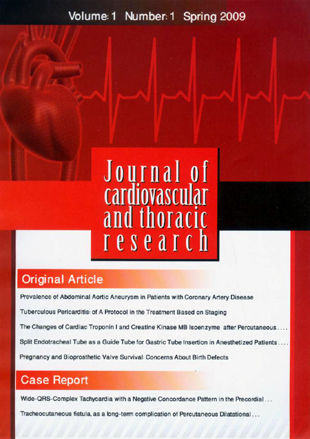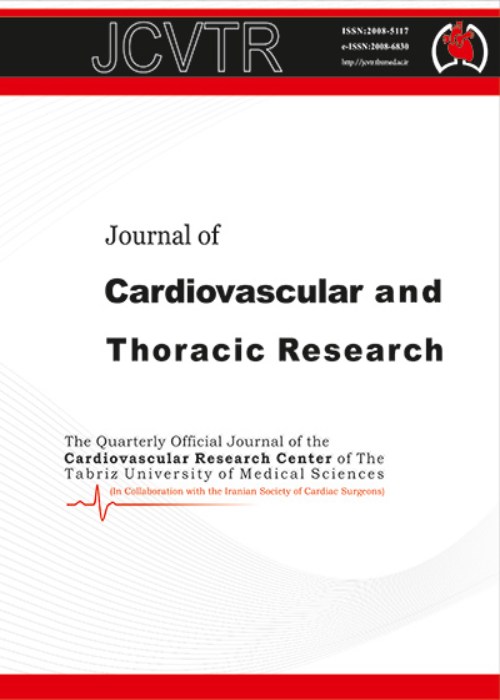فهرست مطالب

Journal of Cardiovascular and Thoracic Research
Volume:1 Issue: 1, Apr 2009
- 46 صفحه،
- تاریخ انتشار: 1388/03/20
- تعداد عناوین: 7
-
-
Page 1Backgraound: The prevalence of abdominal aortic aneurysm (AAA) increases with age and affects almost 5% of the population who are >50 years old. It has been demonstrated that ultrasound examination is accurate in identifying and following patients who have AAA and is favoured as a screening method in subjects who are at high risk. It has been previously demonstrated that, there may be a relation and coincidence between AAA and coronary artery disease (CAD (, however the debate is ongoing. This study aims at evaluating the prevalence of AAA in patients with CAD. Mthods: In an analytic-descriptive cross-sectional study, 234 candidates for coronary artery angiography were studied in Tabriz Imam Khomeini and Madani Hospitals during an 18 month period. Abdominal duplex ultrasonography was employed for examining the cases for presence of AAA, which was considered as presence of abdominal aortic diameter ≥ 30 mm. Frequency of AAA was compared between the two groups.ResultsOne hundred eighty four patients with CAD and 50 age and sex-matched controls without CAD were enrolled in the study. Frequency of AAA was 4.3% in those with CAD versus zero in those without it (p=0.208). According to ROC curve analysis, age of patients with CAD (≥ 67 years) predicted the presence of AAA with a sensitivity and specificity of 75% and 80%, respectively. In this age group, frequency of AAA was 14% and zero respectively in those with and without CAD. Frequency of AAA was 2.2%, 5% and 8.8% in patients with 1vessel, 2vesseles and 3vesseles CAD, respectively (p=0.269).ConclusionAccording to the current study, age is a significant risk factor for AAA in patients with CAD. So it is recommended that the screening program with duplex ultrasonography be considered in older patients with CAD. For determining an exact age-related cut-off point, further studies with larger sample sizes are recommended to be carried out.Keywords: Abdominal Aortic Aneurysm, Duplex Doppler Ultrasonography, Coronary ArteryDisease
-
Page 5BackgroundThere are no available reference values on treatment of tuberculous pericarditis in the literature and seems it remains controversial.MethodsTwenty nine patients (age ranges 9 - 75 years) with tuberculous pericarditis were studied retrospectively in this study. Medical recording of all patients undergoing operation for pericardial tuberculosis at the Cardiothoracic ward of Tabriz University from 1981 through 1998 were reviewed with attention to clinical, operative, pathological features of tuberculous pericarditis. Diagnosis is mostly with pericardial biopsy (85%). Fifteen patients were male and fourteen patients were female. Staging of patients results as follows: Stage I=0; Stage II= 11; Stage III= 10; Stage IV= 6 with tuberculous pericarditis. All stages treated with presented protocol treatment.ResultsTwelve year follow up of patients showed no reccurence or mortality in stages II and III, but one of two patients in stage IV that operated died due to heart failure. This showed us 17% mortality in stage IV and 3.7% mortality in all of stages.ConclusionManagement of tuberculous pericarditis from exudative through constrictive stages has considerable controversy, so in our idea presentation of a protocol for treatment of all stages of tuberculous pericarditis is necessary.Keywords: Treatment protocol, Pericardiectomy, Tuberculous pericarditis
-
Page 11BackgroundPercutaneous transluminal coronary angioplasty (PTCA) with or without stenting is a well established technique for coronary revascularization. The injury to the myocardium during the technique was investigated by measuring serum levels for cardiac troponin I and activity of Creatine Kinase MB Isoenzyme (CK-MB), the sensitive and relatively specific biomarkers of cardiac injury. In this study, to detect minor myocardial injury after PTCA, we evaluated serum levels of CTNI and CK-MB after PTCA.MethodsThe serum levels of CTNI and the activity of CK-MB were measured by standard methods in 100 patients undergoing elective PTCA, before and 12-24h after the procedure. Patients who had hepatic, renal and thyroid disease; recent myocardial infarction; electrocardiographic changes, chest pain and myocardial infarction after intervention were excluded from our study.ResultsMeaningful differences between the mean levels of CTNI in the samples obtained before and after PTCA; 0.67 ± 0.58 ng/ml VS 1.19 ±0.94 ng/ml (P= 0.000) and those of CK-MB activities; 22.89±8Iu/l VS 26.38±13.39 (P=0.010) were noticed. Stenting place had no effect on the measured parameters. Relationships between history of Hypertension, Diabetes, Hyperlipidemia, Previous myocardial infarction, Smoking and elevations of CTNI and CK-MB levels weren’t statistically significant.The frequency of increased levels of CTNI and CK-MB in women was significantly higher than men.ConclusionWe concluded that minor cardiac injury following PTCA may increase the serum level of CTNI and serum activity of CK-MB. CTNI is more sensitive than CK-MB in detecting of the injury and placing stent has no effect on the release of the parameters during the PTCA.Keywords: CK, MB, PTCA, CTNI
-
Page 17Background
Occasionally inserting a gastric tube in anesthetized or unconscious patients may be difficult or failed. Various techniques have been explained to resolve the problem. In a randomized clinical trial, we studied the efficacy and safety of a new method for orally gastric tube insertion in anesthetized patients.
MethodsAlong a 5-month period, 90 adult patients candidate of cardiac surgery randomly allocated in three groups due to methods of gastric tube insertion. Fifteen minutes after anesthesia induction, gastric tube was inserted nasally (NGT group, n=30), simply orally (OGT group, n=30) or orally via an uncuffed split endotracheal tube size 6.0 mm (ETT group, n=30). The success rate, time consumption, hemodynamic changes and complication rates were compared between three groups.
ResultsTwo patients were excluded from the study, because of long intubation time. Demographic and preoperative characteristics were comparable between three groups. Hemodynamic changes due to procedure were not different. Time required for tube insertion in ETT group was significantly shorter than the other two groups (80.60 ± 66.132 sec versus 124.09 ± 100.055 and 139.77 ± 80.363 sec in NGT and OGT groups, respectively) (p=0.012). Success rate was significantly high in ETT group comparing to other two groups (100 percent in ETT group versus 77 and 86 percent in NGT and OGT groups, respectively) (p=0.008). The ETT method was used when procedure was failed in other two methods. Complication rates were not different between three groups and the most common complication was sore throat/odinophagia (17%). Hemorrhagic problems were seen in 5, 3 and one patients in NGT, OGT and ETT groups, respectively.
ConclusionsUsing a split endotracheal tube, as a guide tube, is an effective, fast and safe method for orally insertion of a gastric tube in anesthetized or unconsciousness patient.
Keywords: Gastric tube, Nasogastric tube, Orogastric tube, Anesthetized patient, Insertion method -
Page 23Backgraound: Presently, there is no apparent agreement on the effects of pregnancy on the durability of bioprosthetic valves (BPV). The study aim was firstly to assess the influence of pregnancy on survival of BPV; secondly, maternal and fetal outcomes of pregnancy with BPV.MethodsBetween 1981-2008, of the total patients selected, 31 were assigned to the bioprosthetic valve replacement group who became pregnant (39 pregnancy) after surgery [PAS (+)]; a group of 26 bioprosthetic valve replacement patients were also included whom did not experience pregnancy till the time of study [PAS (-)]. We obtained information on type of repaired valves, outcome of pregnancies and valve surgery related complications survey of the patients by reviewing the follow up files of centers.ResultsThe mean age of PAS (+) and PAS (+) subjects was 32. 19 ± 4. 42 (max=45, min=24) years and 33. 93 ± 6. 58 (max=43, min=23) respectively (p>0. 05). Gehan test shown that there wasn’t significant relation between valves durability in two groups (P= 0. 22، df = 1، χ 2 =1. 49, diagram 1). Reoperation rate, mortality rate between case PAS (+) and PAS (-) was not significantly different (p>0. 05). Live births were recorded in 30 (76. 9%) of pregnancies (1 fetal death). The average of newborns weight was 2200. 32 ± 1116. 6 gr. Upon our findings 21 (70. 0%) of newborns were term and 10 (30. 0%) were preterm.ConclusionAlthough pregnancy does not have a significant influence on structural depreciation of bioprosthetic valves survival and maternal mortality, bioprosthetic valves might be associated with birth defects. (J CardiovascKeywords: Pregnancy, Bioprosthetic, Survival
-
Page 29The initial electrocardiographic evaluation of every tachyarrhythmia should begin by addressing the question of whether the QRS complex is wide or narrow. The most important cause of wide complex tachycardia (WCT) is ventricular tachycardia (VT). However, supraventricular tachycardia (SVT) can also manifest with a wide QRS complex. The ability to differentiate between SVT with a wide QRS due to aberrancy or preexcitation and VT often presents a diagnostic challenge. The identification of whether WCT has a ventricular or supraventricular origin is critical because the treatment for each is different, and improper therapy may have potentially lethal consequences. When all QRS complexes in the precordial leads are either upright or negative (positive or negative concordance, respectively), VT is strongly suggested. Negative concordance is virtually diagnostic of VT generated from the anteroapical left ventricle. We report an extremely rare case of SVT presenting with a WCT and negative concordance.Keywords: Wide complex tachycardia, Ventricular tachycardia, Supraventricular tachycardia, Aberrant conduction
-
Page 33Tracheostomy is a common surgical process which is performed worldwide. Percutaneous Dilatational Tracheostomy (PDT) is a new safe and fast bedside method that was introduced first time by Ciaglia in 1985. With more routine and long-term use of the PDT some new complications are reported. In this case we report tracheocutaneous fistula as a long-term complication of the PDT. The patient was a 53 year-old man who had underwent PDT using Griggs method nine months ago. The complaint was some drainage from the skin lesion. Tracheocutaneous fistula diagnosis was confirmed by radiographic imaging study. The fistula was repaired surgically and the patient was discharged in good condition.Keywords: Percutaneous dilatational tracheostomy, Long, term, Complication, Tracheo, cutaneous fistula


